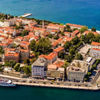
Welcome to the desert! The wild wonders of Wadi Rum

Jordan is primarily a desert country with a landscape full of sand, stones, and shrubs. Wadi Rum – about an hour’s drive from the port city of Aqaba – is the country’s largest desert and has a lot of sand, stones, and shrubs, but it also has green areas. It is both a tourist attraction and a UNESCO World Heritage Site – and will win you over with its incredible natural wonders. Embark on an exploratory trip through the canyons, scale peaks, and relax in a different-kind-of oasis.


All a question of perspective: the Burdah Rock Bridge
At 35 metres, it is one of the highest rock bridges in the world and one of the most popular spots for a photo op in the barren desert. Anyone looking at the Burdah Rock Bridge through a lens will quickly realise: No two photos are the same, because the red sandstone bridge has a myriad of facets, depending on where you’re standing. Initially, it’s barely noticeable from afar among all the massive boulders, but up close, it’s very impressive. If you stand directly below the Bridge and look up, the rock formation could easily pass as the gateway to heaven. When you look at the 360-degree desert panorama, you quite literally feel on top of the world – a once-in-a-lifetime feeling.


A change of planets
It’s not really surprising that Wadi Rum, the Valley of the Moon, is the backdrop for films like Star Wars and The Martian – because this desert is like an alien planet. The synergy between rust-red sand, shade-giving rocks made of millennia-old sandstone, sunbathing lizards, and the glistening blue sky is especially striking in Burrah Canyon. As surreal as the area may seem, every step you take in the gorge will make you feel more and more alive – but make sure that you pinch yourself from time to time.

Thousands of colours – And one night
Not only Burah Canyon is a feast for the eyes in the desert, you should also check out Siq Um Tawaqi once in the morning and once in the evening; This is when the rising and setting sun colours the rock line a dark orange shade. You can stay at the nearby Aladdin Camp to experience these rich colours in real time, because this spot offers a clear view through the glass ceiling of your apartment. Anyone who spends a night in an oriental wooden bed will feel like Aladdin or Jasmine the next day – and definitely not like Jeannie!

A wonder in the desert
We admit, you’ll have to do a double take not to miss the natural wonder of Lawrence’s Spring. When you’re looking at the impressive mountain stretching out in front of you, you’d never guess that there’s a small spring high up on top, making this place an oasis – and thereby an essential place in the dry desert. By the way, this small, wet, and green spot got its name from the British explorer Thomas Edward Lawrence – also known as “Lawrence of Arabia”. At the time of World War I, he not only led desert tribes into battle against the Ottoman Empire, but also fell in love with Wadi Rum.

Megalomania and divinity
“Rum the Magnificent. Vast, echoing and God-like,” is how Lawrence put it. These hymn-like words are especially true for Jabal Ram. Standing at 1,700 metres, it is the second highest mountain in the desert after Jabal Umm ad Dami. Anyone wanting to climb the summit should have some climbing experience. But it's also worth staying grounded and looking at the sharp-edged colossus from below. You can go in search of clues and traces at the foot of the rock. Here, the Nabataeans – an old Arabic nomadic tribe – once built a holy temple, the foundations of which still outbrave wind and weather.
Header - Photo by khaldoon on Adobe Stock
Paragraph 1 - Photo by EyesTravelling on Shutterstock
Paragraph 2 - Photo by Paul Biris on Getty Images
Paragraph 2 - Photo by Alexeiy on Adobe Stock
Paragraph 3 - Photo by Huey Min on Shutterstock
Paragraph 3 - Photo by grandbrothers on Shutterstock
Paragraph 4 - Photo by Roberto Zocchi on Adobe Stock
Paragraph 5 - Photo by gotravel on Alamy
Paragraph 6 - Photo by ecstk22 on Adobe Stock











